Stock recommendations for the year 2026 from $JEF (+1,67 %)
$AVGO (-0,35 %)
$SNOW (-2,34 %)
$NU (+2,71 %)
$CAT (+3,71 %)
$VNET (+6,94 %)
$TCEHY (+5,36 %)
$300750
$7013 (+1,34 %)
$GMG (+0,28 %)
$LR (+0,37 %)
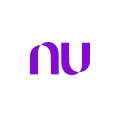
Puestos
312Stock recommendations for the year 2026 from $JEF (+1,67 %)
$AVGO (-0,35 %)
$SNOW (-2,34 %)
$NU (+2,71 %)
$CAT (+3,71 %)
$VNET (+6,94 %)
$TCEHY (+5,36 %)
$300750
$7013 (+1,34 %)
$GMG (+0,28 %)
$LR (+0,37 %)
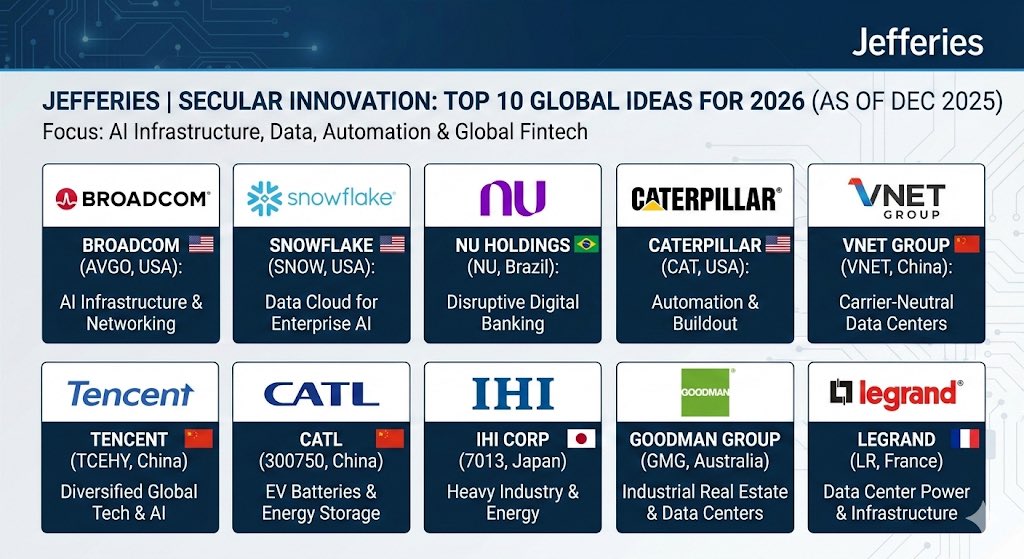


Hello everyone,
I wanted to share a project I started over the holidays. I have decided to invest capital of 20.000 € for the year 2026 into the MSCI World, but to set up a dynamic strategy with the help of Google AI Gemini - as my personal "investment advisor", so to speak.
The initial situation & task for the AI:
I set Gemini the task of developing a system that maximizes return opportunities while limiting losses in an extremely disciplined manner. The whole process was divided into two phases:
Phase 1: The Santa Claus Rally (until 05.01.26)
In order to start the year with momentum, a transitional portfolio (10k starting capital) is currently running, which is fully focused on the historic year-end rally. I had set Gemini this task in order to ideally capture some returns over the holidays. Gemini has developed this portfolio (the AI made several suggestions, which I then implemented with 10K Invest on 23.12.):
Phase 2: The "Vision 26" main portfolio (from 05.01.26)
Here Gemini now recommends a long-term 40-40-20 structure (Basis / Growth / Crypto). The special feature is the control via a score system developed by the AI (0-10 - 10 is "Strong buy"). I can also share this if you are interested - Gemini has developed this score indicator according to my specifications and uses it to scan the possible investments. The following applies:
Current top picks of the AI - I should get into these soon (as score > 7):
Constellation Energy (CEG): AI Energy Play (Nuclear).
Nu Holdings : Fintech disruptor in LATAM.
Microsoft: As a defensive AI anchor.
What other tasks does Gemini perform for me?
The AI acts like an asset manager: I receive daily updates at the market open and close, as well as Sunday briefings in the style of a professional stock market letter. Gemini analyzes the score point values, checks technical support zones and then makes recommendations for action or consistently reallocates when the data says so - no emotions.
What is your opinion?
I am really surprised at what the AI has developed. Of course, it is an offensive portfolio that relies on momentum. But I also told Gemini that I want maximum expected return with high risk. Gemini now estimates this at 18-25% p.a.
What do you think of the approach and the proposed Vision 26 portfolio? I will now implement and test it - I will be happy to keep you up to date.
I'm looking forward to your input!
$MSFT (-2,41 %)
$NU (+2,71 %)
$AMZN (-1,83 %)
$BTC (+1,07 %)
$ETH (+0,91 %)
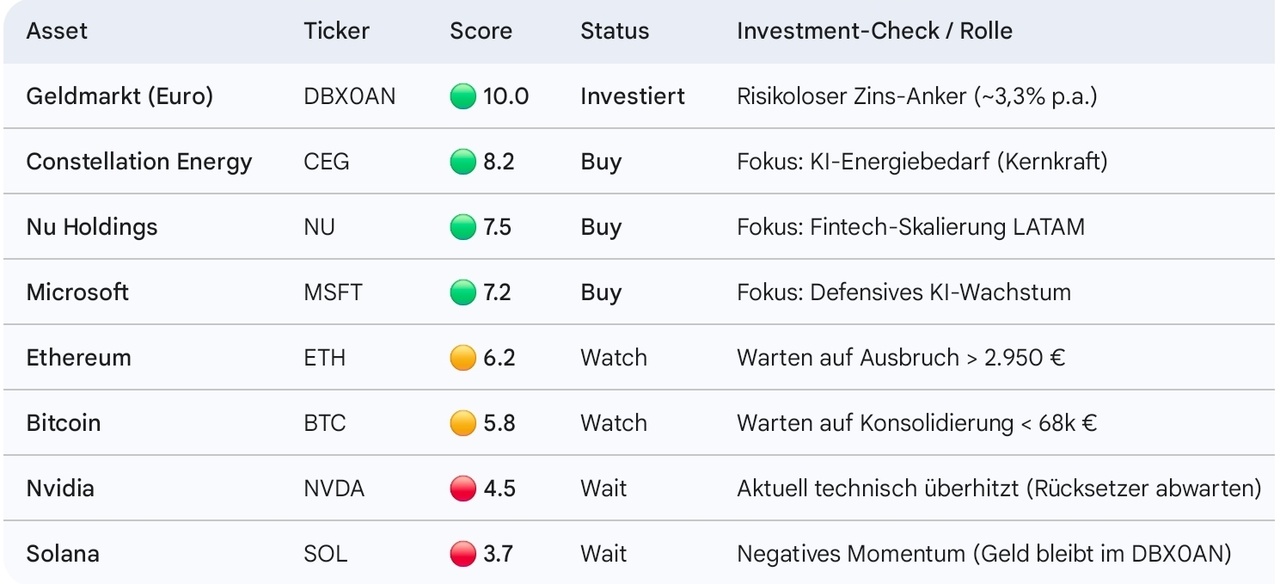
Two fintech stars, legacy winner vs risky challenger, both with a fair risk/reward?
Latin America is the place to be right now for fintech startups, as it has produced some of the most impressive stories over the last decade, and Nu and Inter sit right at the center of that narrative. The continent is on an upward trajectory, by any metric: whether it’s quality of life, income, healthcare, democracy, etc. In an era of rising globalization, the emerging markets are arguably the largest beneficiaries. And if you play it nicely as a founder and CEO, ruthless execution can lead to exorbitant success.
I’ve followed Nu’s rise ever since I started investing a few years ago, and even owned it twice before, both times walking away with roughly 50% profits. Nu has capitalized perfectly on Latin America’s winning streak, showing only minimal signs of weakness, especially self-inflicted. But more recently, I’ve also delved deeper into Inter. So, here are my thoughts on both:
Let’s start with Nu, the “legacy” player, as much as you can call a neobank legacy. It dominates large parts of Brazil (over 60% of adults use it regularly), keeps expanding across LatAm, and benefits massively from smartphone adoption and financial inclusion. Management has shown that relentless execution is the only thing that works in a more volatile environment. Expansion, yes, but thoughtful, so as not to trip over your own feet. This led to outstanding growth, and there’s no debate about it: projected top-line growth north of 30% annually for the next three years, with net income expected to grow closer to 50%. That’s elite, and the market knows it by now.
The stock is already up more than 60% this year and trades at a forward P/E of around 29. Yes, that drops to roughly 15 on 2027 estimates, but those numbers still need to be delivered in a region where currency risk, governance issues, corruption, macro instability, and geopolitics are very real. I’m not saying Nu can’t do it, just that the risk/reward no longer screams bargain.
Inter is the smaller, less established player. It shows similar growth dynamics to Nu but operates with less scale, less brand power, and more execution risk. That’s why it trades much cheaper: forward P/E around 14, and closer to 8 on 2027 earnings if everything goes right. On paper, that’s tempting (really tempting for me, actually). But in reality, the risks are meaningfully higher. Cheaper doesn’t always mean better.
For now, I’m happy with my emerging market fintech exposure through dLocal, MercadoLibre, and Sea. All three are significantly cheaper and/or enjoy stronger market positions, in my view. Nu and Inter remain fascinating stories, and I’ll keep watching closely, but at current prices, this feels more like a fair bet than a great one.
$NU (+2,71 %)
$INTR (+5,49 %)
$DLO
$MELI (-1,86 %)
$SE (-0,22 %)

Hi all,
Looking for advice and opinions.
I don’t want to many positions in my portfolio, I therefore am looking to sell 2 companies as I don’t want to own too many companies– diversification is good, but no one got rich on their 7th best idea. Here are my thoughts, looking forward to hearing yours!
PayPal $PYPL (-1,48 %)
I’m currently evaluating if I should sell my PayPal position. I think Mr. Market is wrong about PayPal. In my opinion the value of PayPal is higher than its current valuation. With that being said, PayPal is my smallest position, and I’m not convinced about the company’s’ ability to grow (as compared to its competitors).
AliBaba $BABA (+4,98 %)
In Alibaba I used to believe there was a lot of upside, many were fearful as there are a lot of tensions going on around China. Recently Alibaba has seen a lot of growth, mainly due to their strong position on AI. When looking at the core of Alibaba (the e-commerce platform) I’ve lost my conviction, many analysts are bullish on Alibaba for their progress in AI. What do you think?
Nvidia $NVDA (+0,47 %)
For Nvidia I am bullish, the numbers are amazing, however I fear this may bring risks. Whenever numbers are short of being perfect, the market will overreact. Should I sell now and wait for a correction of some sort? Also, seriously doubting whether Nvidia has hit the ceiling or not. They are currently the largest company ever; how much bigger can it get?
META $META (-0,91 %)
META is another earnings powerhouse and a stock I like long term. My only concern is whether Mark is overspending on AI investments. Time will tell. :)
UnitedHealth $UNH (+2,52 %)
UnitedHealth is a great company with strong fundamentals, a wide moat, and an attractive valuation. My only worry is the criticism of the US healthcare system and companies like UNH. It’s a political issue for many, and I’m worried margins could decline in the long run.
ASML $ASML (+7,43 %)
& Nu Holdings $NU (+2,71 %)
I see a lot of potential for ASML and Nu Holdings. I am not considering to sell them.
I am a long-term investor and I’m not looking to sell very often, I will keep my stocks for the next 10 years at least. Currently I feel the need to rebalance as I learn more every day.
In which stock do you see a lot of long-term potential?
I will be researching the following:
$NU (+2,71 %)
Nubank expands credit offering and reaches 4 million customers in Colombia
Nu Holdings Ltd. is experiencing strong growth in Colombia and has reached 4 million customers. The company is selectively expanding its local loan portfolio and introducing innovative products such as Moradita, NuControl and Morada Abre Caminos to improve access to financial services and promote financial inclusion. In addition, two new credit lines, Préstamo Ligero and Préstamo Personal Nu, were introduced in 2025.
Nu's digital account platform is already one of the five largest deposit bases in the country.
Source: reuters.com
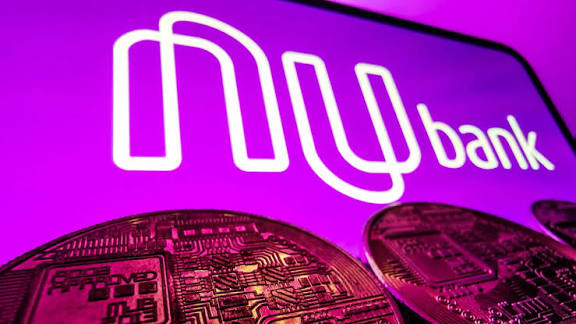
After a stable October (+6.2%), there was a clear countermovement in November.
My portfolio fell to 39.328€ and was thus -3,9% compared to the previous month.
The main drivers were the strong sell-offs in AI software, uranium, mining and defense - precisely those areas that are overweighted in my allocation.
Despite the setback, the year as a whole remains strong:
👉 Year-to-date I am still at +20.4% - solidly in the green.
1st performance & comparison 🚀
November was clearly characterized by risk-off mode. While broader indices remained stable, highly volatile future themes corrected much more strongly.
My portfolio:
-3,9%
NASDAQ 100:
-2,56%
S&P 500:
-0,49%
DAX:
-0,55%
FTSE All-World:
-0,48%
The underperformance is fully explainable:
Uranium, AI software, bitcoin mining and defense were under pressure - all segments that my portfolio partly tracks. But we remain calm and use attractive setbacks to buy.
Positive:
The long-term trend structure remains intact, YTD +20,4% clearly show: The overall path is right.
2. my savings plans & allocation 💶
The focus remains unchanged on strategic liquidity and consistent allocation.
Important in November:
👉 I bought Bitcoin for the first time.
This expands my structure specifically in the direction of digital assets - a building block that has shown relative strength despite market volatility. We entered at €74665 and are trying to use the 30% drop since the ATH to build up a small anti-cyclical position.
My savings plans are continuing as usual and remain the tactical tool for exploiting market opportunities in a disciplined and unemotional manner.
3rd top mover in November 🟢
The month was led by Nubank ($NU (+2,71 %)), which was up +8,06 % benefited from strong user numbers and continued high demand for credit in Latin America. Berkshire Hathaway ($BRK.B (-0,28 %)) gained +7,40 % driven by solid insurance profits and defensive positioning in the current market environment.
American Lithium (+4.44 %) showed a technical recovery, while the Bitcoin purchase ($BTC (+1,07 %)) in my portfolio with +3,39 % had a direct positive effect. Also small caps (MSCI World Small Cap ($WSML (+0,41 %)) +1.31 %) also performed stably. Tomra Systems ($TOM (+1,35 %)) rounded off the list of winners with a slight gain of +0,28 % driven by an incipient recovery in demand in the recycling segment.
4th flop mover in November 🔴
The month was much weaker for my highly volatile AI and energy segments.
IREN ($IREN (+8,25 %)) fell by -21,27 % the strongest - burdened by pressure in the mining sector and falling BTC margins. Also Cloudflare ($NET (-0,9 %)) also fell -21,19 % triggered by risk-off in the entire software/infrastructure tech sector.
The VanEck Uranium ETF ($NUKL (+5,4 %)) slipped -17,48% after falling spot prices and geopolitical uncertainties led to widespread profit-taking.
Tempus AI ($TEM (+0,94 %)) (-13,24%) and Rheinmetall ($RHM (+3,09 %)) (-12,99%) suffered from a general revaluation of growth and defense stocks. Mercado Libre ($MELI (-1,86 %)) closed the month with -10,00 % also significantly weaker, weighed down by consumer data from Latin America.
5. conclusion 💡
November was a classic rotation month: risk-off in speculative future themes, stability in value, fintech and more defensive positions.
❓Question for the community
Which position surprised you the most in November - positive or negative?
👇 Write it in the comments!
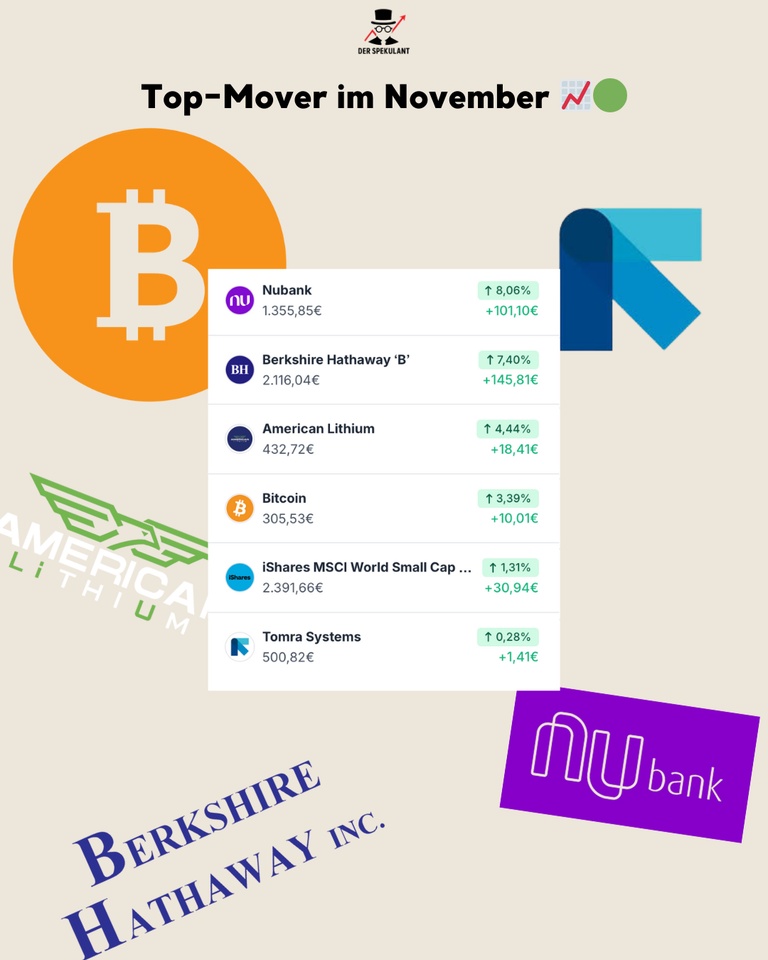
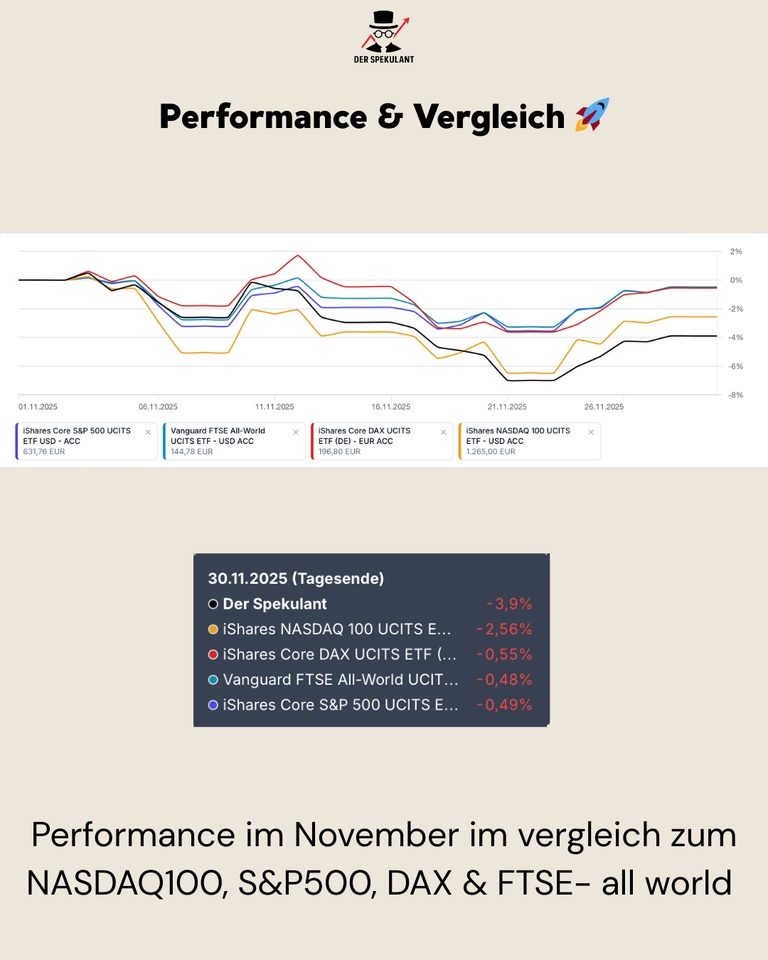
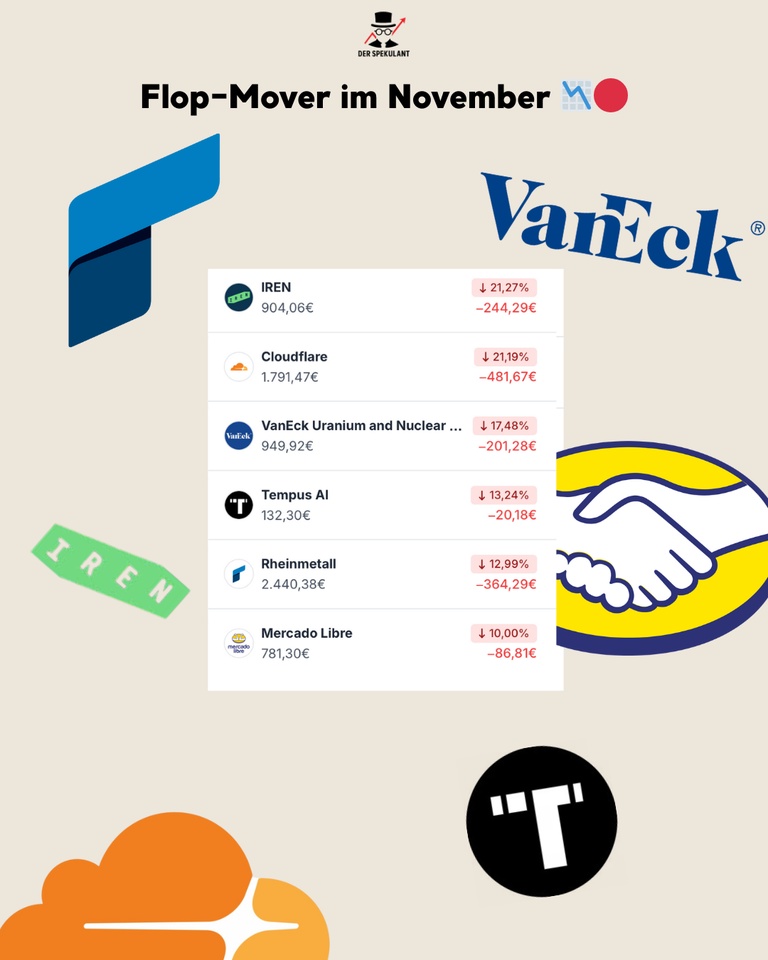
+ 2
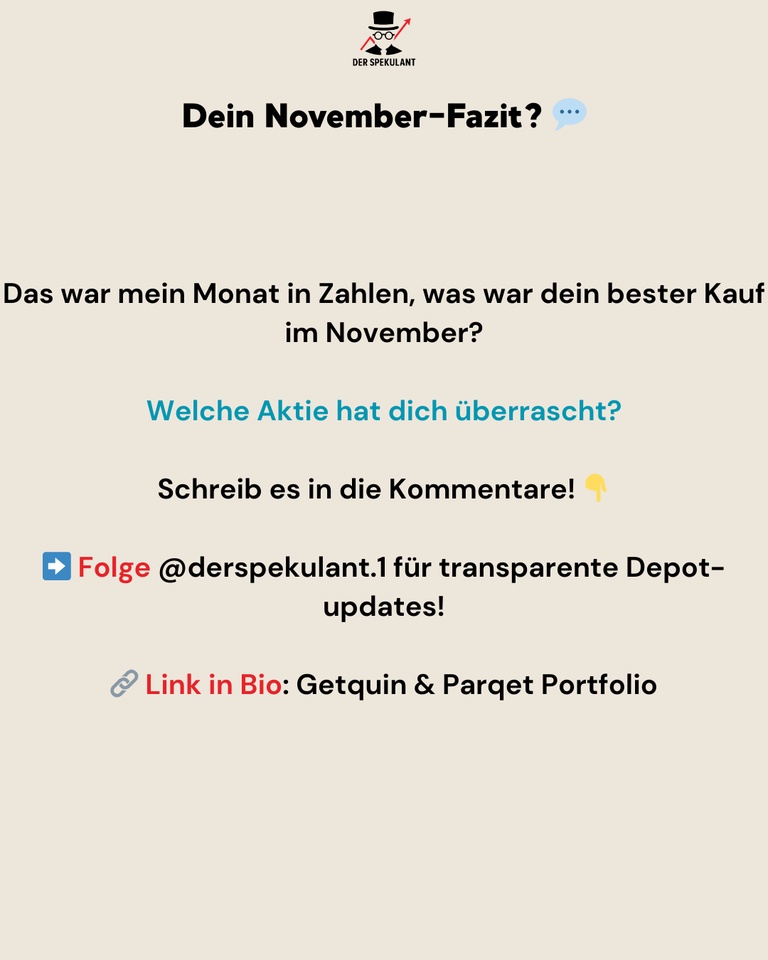
Congratulations to all those who took the plunge almost a year ago at $NU (+2,71 %) the falling knife!
Now everyone is in the black!
Congratulations on the all-time high 💪🔥 20$ next? 📈

I realized that my portfolio is very tech-heavy and has been underperforming the market the last few days. I thought I would ask several AIs (for fun) how they would adjust my portfolio to remain growth-oriented but with more diversification and some stability.
Here is the list:
Tech:
6% $NV
5% $2330
5% $PANW (-3,65 %) (new)
6% $INTU (-5,83 %) (new)
Industry:
3% $ETN (+1,93 %) (new)
Health:
4% $LLY (+0,37 %) (new)
3% $ISRG (-1,95 %) (new)
Finances:
4% $V (-1,75 %)
Energy/commodities:
6% $LIN (+0,83 %) (new)
2% $NEE (+1,03 %) (new)
Infrastructure:
3% $WM (-1,55 %) (new)
Consumption:
9% $COST (-0,81 %) (new)
The Ki:
BYD, Xiaomi, Iris Energy, Hims and Hers, Sofi, Applied Digital, Coreweave, Ondas, Rocket lab. Quasi China and all the hype stocks
However, AI has been arguing with itself. It thought Crowdstrike should be replaced by Palo Alto and, if Palo Alto was in, it should be replaced by Crowdstrike. The same with Novo and Eli lilly, visa and mastercard, salesforce and service now.
What do you think of the AI "optimized portfolio"?
My path to financial freedom. My investment horizon is around 15 years.
Target weighting
30 % ETF $SP20 (-0,66 %)
30 % shares
$AMD (+3,82 %)
$ASML (+7,43 %)
$SHOP (-5,64 %)
$NOW (-4,02 %)
$NU (+2,71 %)
$META (-0,91 %)
$FTNT (-2,71 %)
$ANET (-0,77 %)
$NFLX (-2,61 %)
$APP (-11 %)
$CRWD (-4,2 %)
20% Bitcoin $BTC (+1,07 %)
10% gold $EWG2 (-0,83 %)
5% P2P Bondora Go&Grow
5% Cash cushion $ERNX (+0,09 %)
the strategy is always individually adapted.
Principales creadores de la semana